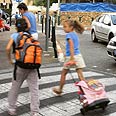
13% of Jerusalem first-graders are secular
צילום: נמרוד גליקמן
Only 1 in 8 pupils in Jerusalem is secular
Ynet inquiry reveals only 1,950 of 15,333 first-grade students in capital not religious - a significant drop from figures compiled decade ago. Some 61% of Jewish students are ultra-Orthodox -twice more than their representation in adult population. Senior researcher: This is result of high haredi fertility rate
Secular Jews in Jerusalem feel as though the city is slipping between their fingers. Now these concerns have statistical proof. A Ynet inquiry revealed that just 1,950 of 15,333 first-grade pupils registered for the current school year in the municipal school system are secular, making them a mere 12.7%.
In actuality, the secular students make up an even smaller relative portion of the city's pupils because thousands of Arab students who study at private schools in the city were not included in the statistics.
The figures, which are extrapolated from statistics from the Jerusalem Institute for Israel Studies, are based on the character of the schools in which students are enrolled.
While the number of secular students enrolled in public schools is about an eighth of all first-graders in the capital, haredi students make up 40% of the age group. Thirty-four percent of first-grade pupils are Arab (not including private schools), and 13% are National Religious, showing a similar representation as secular students.
For the sake of comparison, during the 2000-2001 schools year, the percentage of secular students in first-grade classes in Jerusalem was 19%. Ever since, there has been a steady decline in the percentage of secular pupils in the capital.
The opposite is true for Arab and haredi pupils. A decade ago, haredi pupils were 45% of the first-grade class, and Arabs were 22%. The increase in Arab pupils' representation is partially attributable to a number of educational facilities that have recently received recognition from the State.
Among Jewish students, haredi students make up 61% of the first-grade age group. Just 19% are secular, and another 19% are National Religious. The percentage of haredi pupils in that age group is double the relative representation of haredim in the adult Jerusalem population, which is a bit less than 30%.
"This is a result of the haredi fertility rate, which stands at close to eight children on average per woman throughout the country. The result is that the relative portion of their children is much larger," explained Dr. Maya Chosen, a senior researcher at the Jerusalem Institute to Ynet. Dr. Choshen is also the editor of the Jerusalem Statistical Yearbook.
Dr. Choshen explained the low rate of secular students in the young age groups: "The secular population is relative older. There are very many students among young secular Jerusalemites who usually do not give birth here. These things together show an interesting picture, that indicates the diversity of sectors in city of Jerusalem. There is no other city in Israel that is so diverse."
However, Dr. Choshen emphasized that the demographic picture painted by the first-grade statistics must not be projected onto the future of the capital. "It is important to address statistics of those leaving the city. It is hard for seculars, religious, and haredim alike to rent apartments, and a large section of these children will not live here," she summarized.










